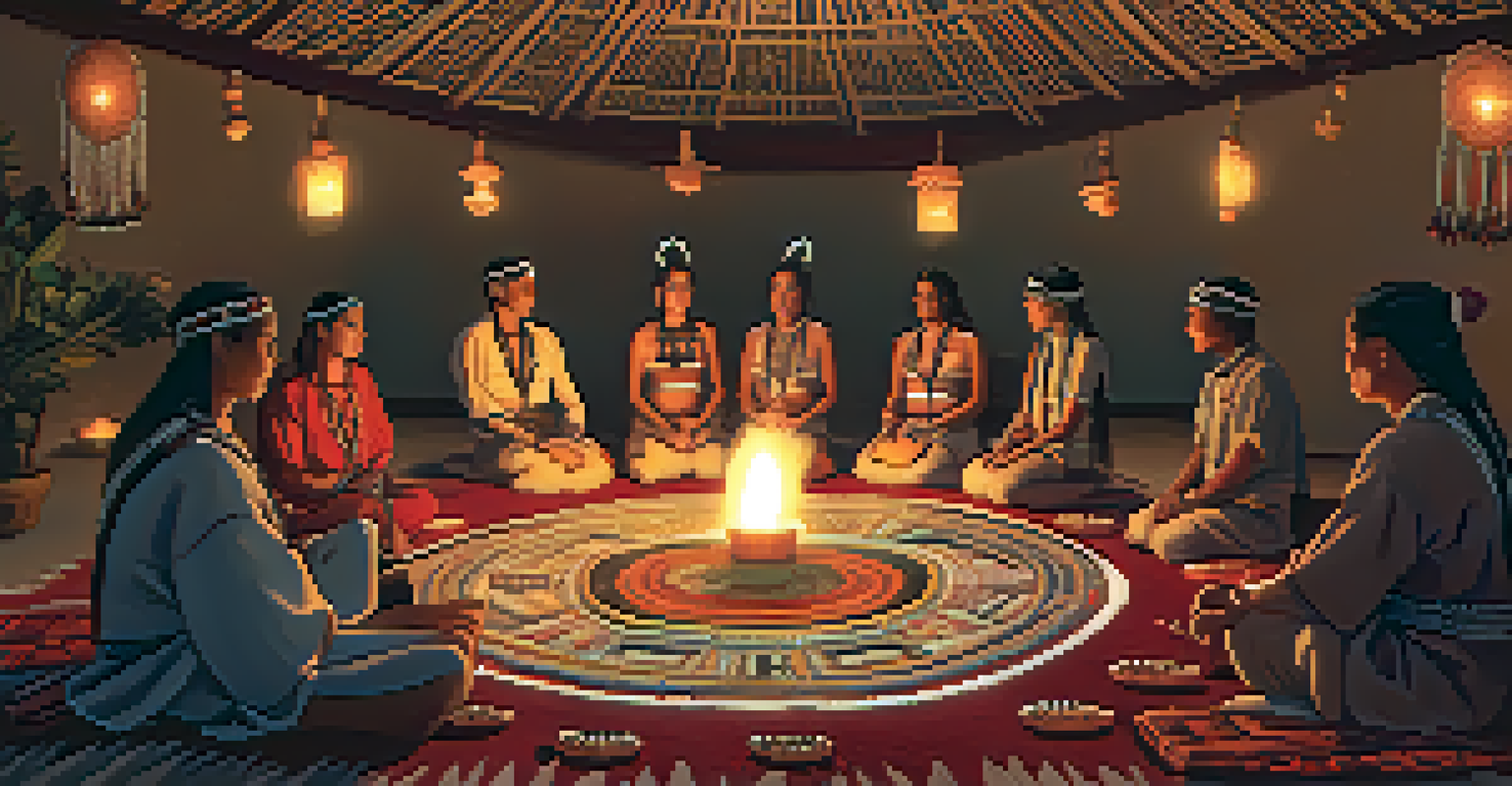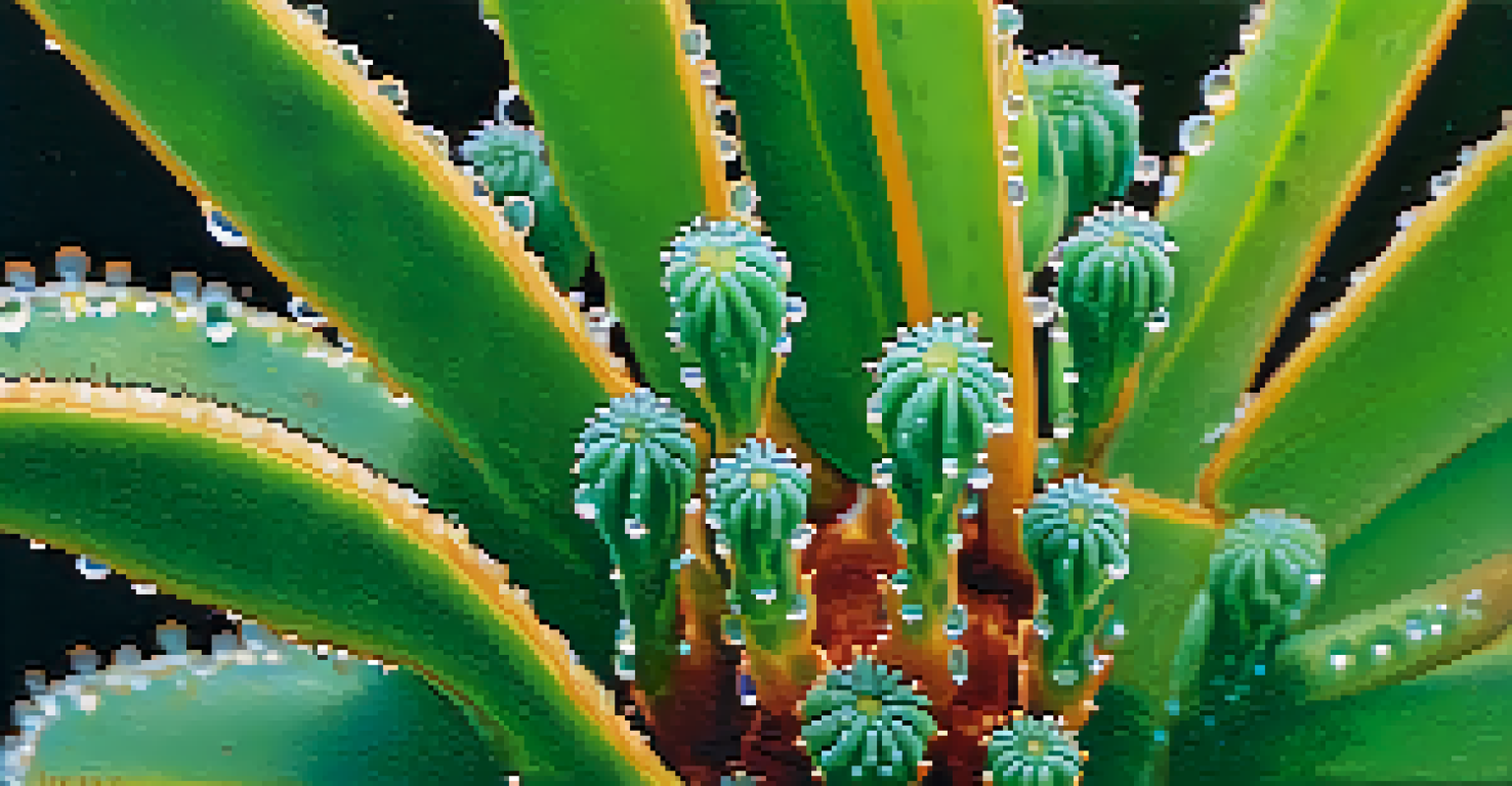The Decline of Traditional Peyote Use Post-Colonization

Understanding Peyote and Its Cultural Significance
Peyote, a small cactus native to North America, holds deep spiritual significance for many Indigenous tribes, particularly the Huichol and the Navajo. Traditionally, peyote was used in religious ceremonies, offering a pathway to spiritual insights and healing. The vibrant history of peyote use is intertwined with the identity and culture of these communities, making it far more than just a plant—it’s a sacred symbol. Understanding this context is crucial when discussing the impact of colonization on its use.
The plant is not a drug. It is a sacrament, a way of reconnecting with the spiritual world and with our ancestors.
For centuries, Indigenous peoples cultivated and utilized peyote without interference, passing down knowledge and practices through generations. The rituals surrounding peyote were holistic, incorporating community, spirituality, and personal growth. However, the arrival of European colonizers marked the beginning of a tumultuous relationship with Indigenous practices, including the use of peyote. As colonizers sought to impose their own beliefs, the cultural significance of peyote began to face unprecedented challenges.
The spiritual ceremonies involving peyote were not just personal experiences; they were community events that fostered connection and shared understanding. As colonization progressed, these ceremonies were often misunderstood or outright banned, leading to a decline in traditional peyote use. Thus, peyote became a symbol of resistance and identity for Indigenous peoples, even as external forces sought to diminish its importance.
Impact of Colonization on Indigenous Practices
Colonization brought about significant disruptions to Indigenous ways of life, with traditional practices facing systemic suppression. Many European settlers viewed the spiritual practices of Indigenous tribes as primitive or misguided, leading to efforts to eradicate them. This not only affected the use of peyote but also the broader cultural and spiritual landscape of Indigenous communities. The imposition of foreign beliefs often left a void where traditional practices once flourished.

As colonizers established their presence, they enforced laws and policies that marginalized Indigenous peoples, including restrictions on religious practices. This suppression often resulted in the criminalization of peyote use, further discouraging its traditional application. The repercussions of these actions were profound, creating a disconnect between younger generations and their cultural heritage. Many Indigenous communities found themselves grappling with the loss of identity and the fading of their ancestral practices.
Peyote's Cultural Significance
Peyote holds deep spiritual importance for Indigenous communities, particularly the Huichol and Navajo, serving as a sacred symbol deeply intertwined with their identity.
Despite these challenges, some Indigenous groups continued to protect and practice their peyote rituals in secrecy, showcasing resilience. This struggle against colonization's impact reflects a broader narrative of cultural survival and adaptation. The decline of peyote use in the open has led to a rich underground history, where practices persisted even when they were forced into the shadows. This hidden resilience highlights the importance of peyote as a symbol of cultural continuity.
The Role of the Native American Church
The establishment of the Native American Church in the early 20th century marked a pivotal moment for peyote use among Indigenous peoples. This organization sought to provide a legal framework for the use of peyote in religious ceremonies, helping to revitalize its practice amidst colonization's pressures. By integrating peyote into a structured religious context, the church aimed to reclaim spiritual sovereignty for Indigenous peoples. It served as a bridge between traditional practices and a modern legal landscape.
Cultural appropriation is the theft of culture, while cultural appreciation is the respect and understanding of it.
Through the Native American Church, peyote use became a form of resistance and cultural affirmation. The church’s rituals emphasized the importance of peyote not just as a sacrament but as a connection to the divine and to one’s ancestors. This revitalization effort helped restore a sense of community and belonging among its members. The church played a vital role in preserving not only the use of peyote but also the broader spiritual practices tied to it.
However, the church's approach to peyote also faced scrutiny and opposition from both external authorities and some Indigenous groups. Critics argued that the church's structure could dilute traditional practices. Yet, the church remains a crucial element in the ongoing dialogue about peyote use, serving both as a protector of tradition and a negotiator with a changing world. It represents a complex evolution of peyote's role in Indigenous spirituality post-colonization.
Modern Challenges Facing Peyote Use
In contemporary society, peyote use continues to face numerous challenges, particularly from legal and environmental perspectives. While the Native American Church has provided some legal protection for peyote use, it still exists within a complex legal framework that varies by state. Moreover, the increasing demand for peyote has raised concerns about its sustainability and availability. Overharvesting and habitat loss threaten the very plant that holds such significant cultural value.
The growing interest from non-Native individuals in peyote as a recreational or spiritual tool adds another layer of complexity to its use. This trend can lead to cultural appropriation, where the deep-rooted meanings and contexts of peyote are overlooked. It's vital to recognize that for Indigenous peoples, peyote is not just a substance but a sacred entity with profound significance. This disconnect can further exacerbate the decline of traditional practices, as the focus shifts away from their cultural roots.
Impact of Colonization
Colonization led to the suppression of Indigenous spiritual practices, including peyote use, causing a cultural disconnect and forcing traditional ceremonies underground.
In response to these challenges, many Indigenous leaders are advocating for the protection of peyote and its traditional use. Efforts include educational initiatives to raise awareness about the cultural importance of peyote and the need for sustainable practices. By fostering a deeper understanding of its significance, there is hope for revitalizing traditional peyote use in a manner that honors its heritage. This struggle reflects a broader commitment to preserving Indigenous cultures in a rapidly changing world.
Cultural Revitalization Efforts
In recent years, there has been a growing movement among Indigenous communities to revitalize traditional peyote practices. These efforts often focus on reconnecting younger generations with their cultural heritage and the spiritual significance of peyote. Workshops, ceremonies, and community gatherings serve as platforms for sharing knowledge and experiences related to peyote use. This cultural revival not only fosters a sense of identity but also strengthens community ties.
Moreover, storytelling plays a crucial role in these revitalization efforts. Elders share their experiences and teachings about peyote, passing down wisdom that honors ancestral practices. This intergenerational dialogue helps bridge the gap between past and present, ensuring that traditional knowledge is not lost. By incorporating modern approaches to education, such as digital storytelling, communities are finding innovative ways to engage youth with their heritage.
Additionally, collaborations with environmental organizations are emerging to address the sustainability of peyote. By focusing on conservation efforts, Indigenous communities are working to protect peyote habitats while also ensuring the plant's availability for future generations. These initiatives reflect a holistic approach to revitalization, where cultural practices are intertwined with environmental stewardship. Ultimately, these efforts highlight the resilience and adaptability of Indigenous cultures in the face of ongoing challenges.
The Future of Peyote Use in Indigenous Communities
As Indigenous communities continue to navigate the complexities of modern society, the future of peyote use remains a topic of critical importance. The ongoing dialogue around cultural preservation and legal rights will shape how peyote is utilized in the years to come. Many communities are exploring innovative ways to integrate traditional practices with contemporary realities, ensuring that peyote remains a vibrant part of their spiritual lives. This adaptation can foster resilience in the face of ongoing challenges.
Furthermore, intertribal collaborations are becoming increasingly important as communities come together to advocate for the protection of peyote and its traditional use. By sharing resources, knowledge, and strategies, Indigenous groups can strengthen their collective voice in advocating for legal protections. This unity reflects a broader movement toward cultural sovereignty, where Indigenous peoples reclaim ownership of their spiritual practices. The future of peyote is not just about preservation but about revitalization and empowerment.
Revitalization Efforts
Indigenous communities are actively working to revitalize traditional peyote practices and strengthen cultural ties through education, storytelling, and environmental stewardship.
Ultimately, the journey of peyote use in Indigenous communities is a testament to resilience and cultural survival. As younger generations embrace their heritage and engage with traditional practices, there is hope for a renewed connection to peyote's spiritual significance. By addressing contemporary challenges with a focus on sustainability and education, Indigenous communities can ensure that peyote continues to play a central role in their cultural and spiritual landscapes for generations to come.
Conclusion: The Resilience of Indigenous Cultures
The decline of traditional peyote use post-colonization serves as a microcosm of the broader struggles faced by Indigenous cultures around the world. Despite centuries of oppression and attempts at erasure, many Indigenous communities continue to fight for their cultural identity and spiritual practices. The story of peyote is one of resilience, reflecting the enduring connection between people, land, and tradition. As these communities reclaim their heritage, they challenge narratives of colonialism and assert their right to exist authentically.
Understanding the complexities surrounding peyote use invites deeper conversations about cultural appropriation, sustainability, and respect for Indigenous knowledge. It encourages us to reflect on our relationship with nature and spirituality, recognizing the wisdom that Indigenous cultures offer. By supporting Indigenous-led initiatives and honoring traditional practices, we can contribute to a more equitable future that respects cultural diversity.

In conclusion, the future of peyote use hinges on the collective efforts of Indigenous peoples to reclaim and revitalize their traditions. As they navigate the challenges of contemporary society, their resilience serves as an inspiration for all who seek to connect with their roots and embrace cultural heritage. The journey of peyote is not just about a plant; it is about honoring a legacy that continues to thrive in the hearts of those who cherish it.